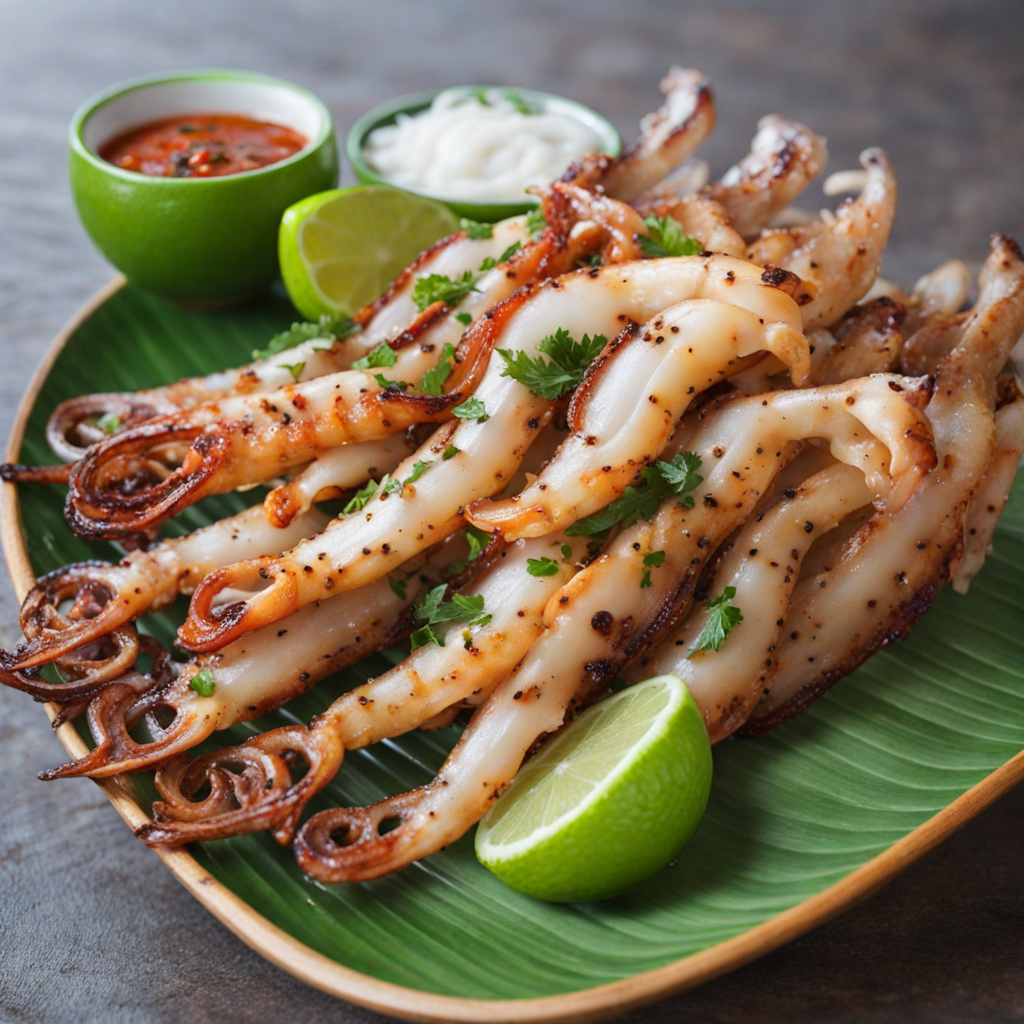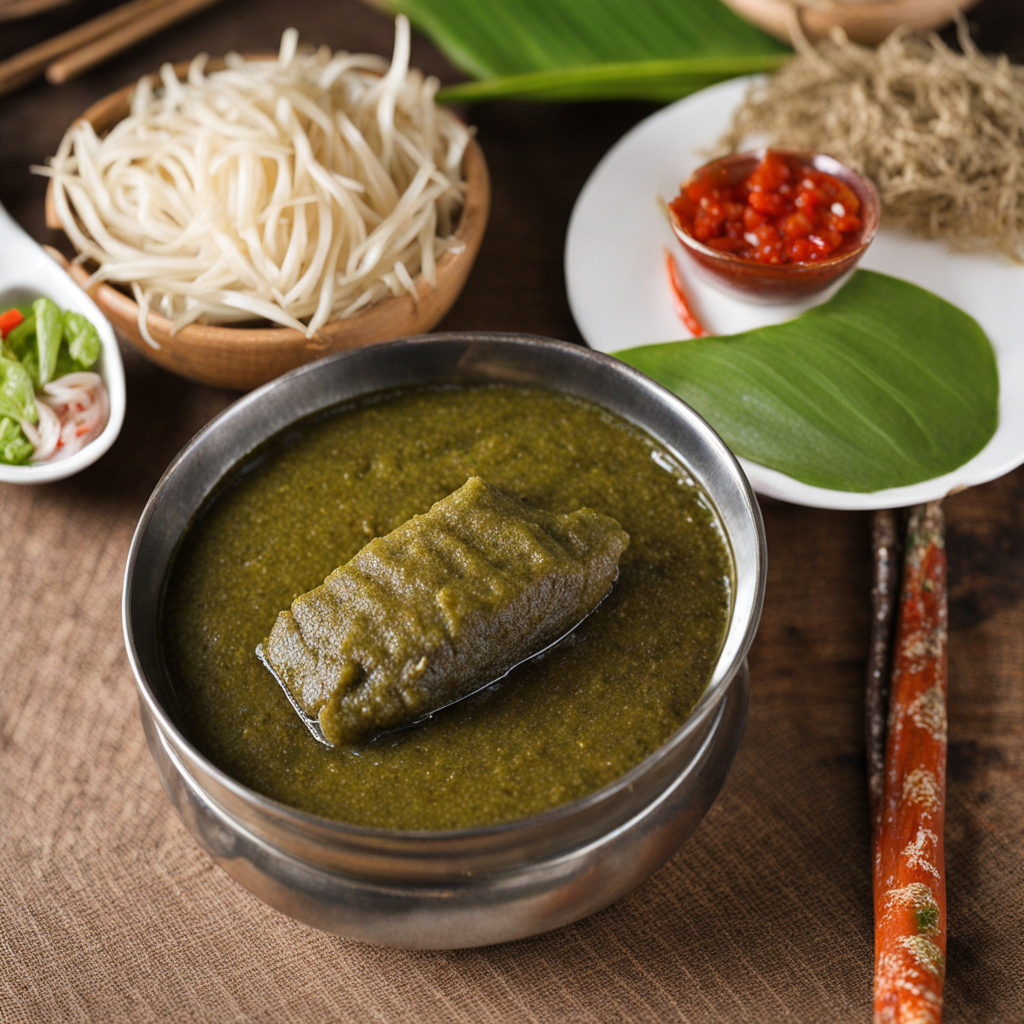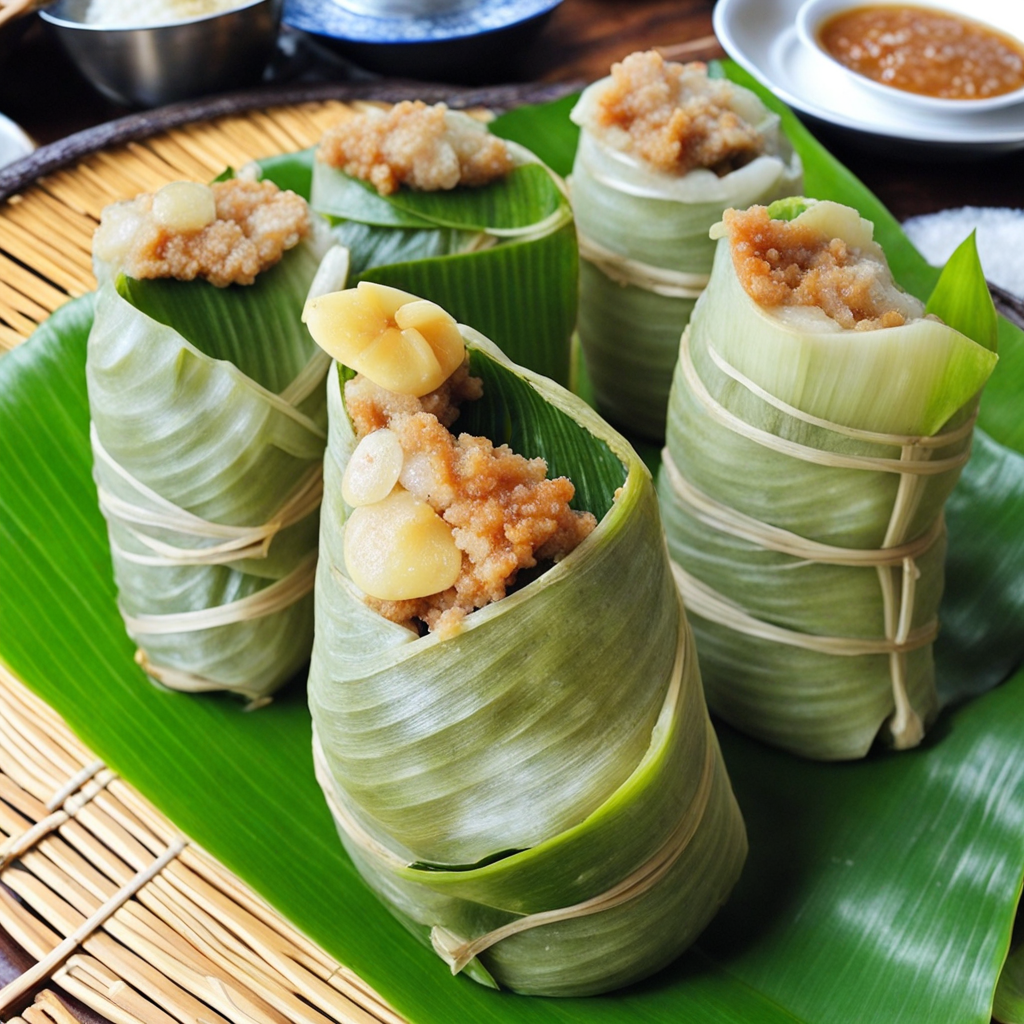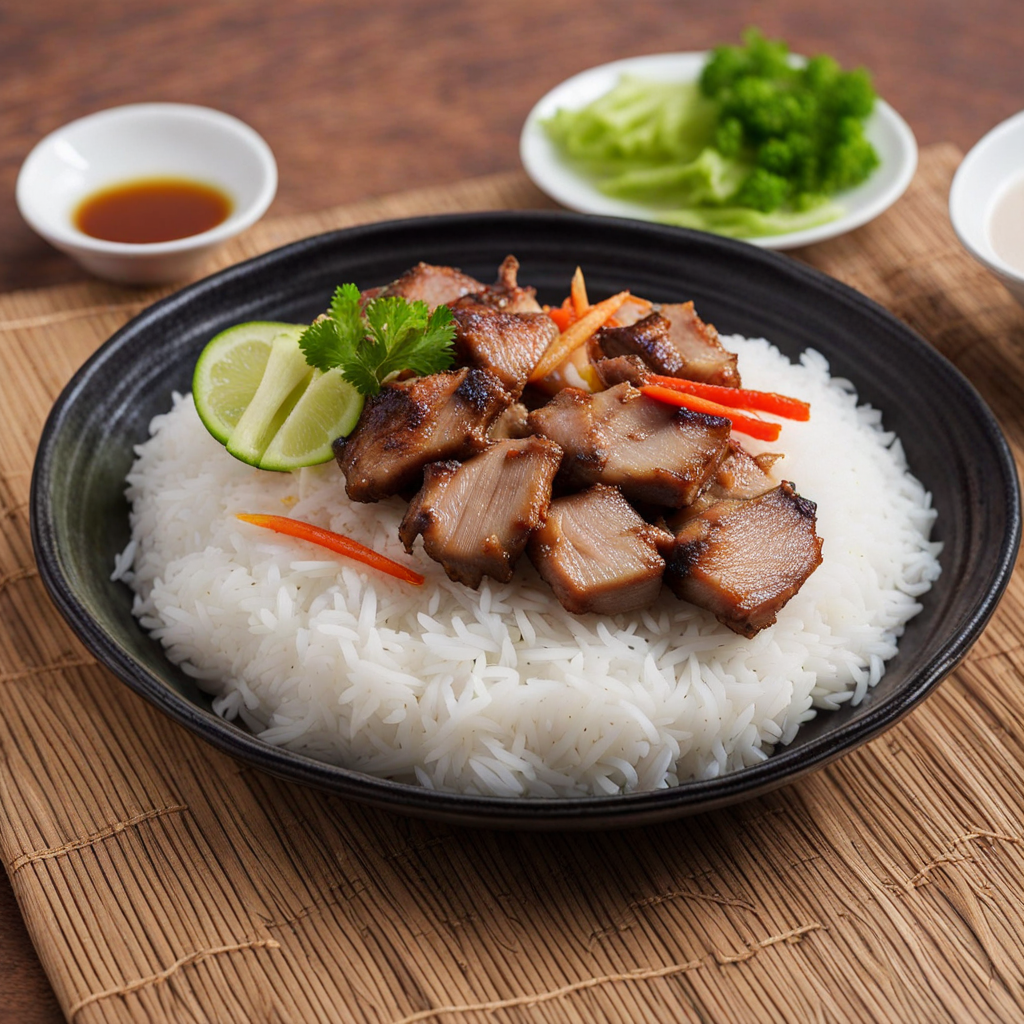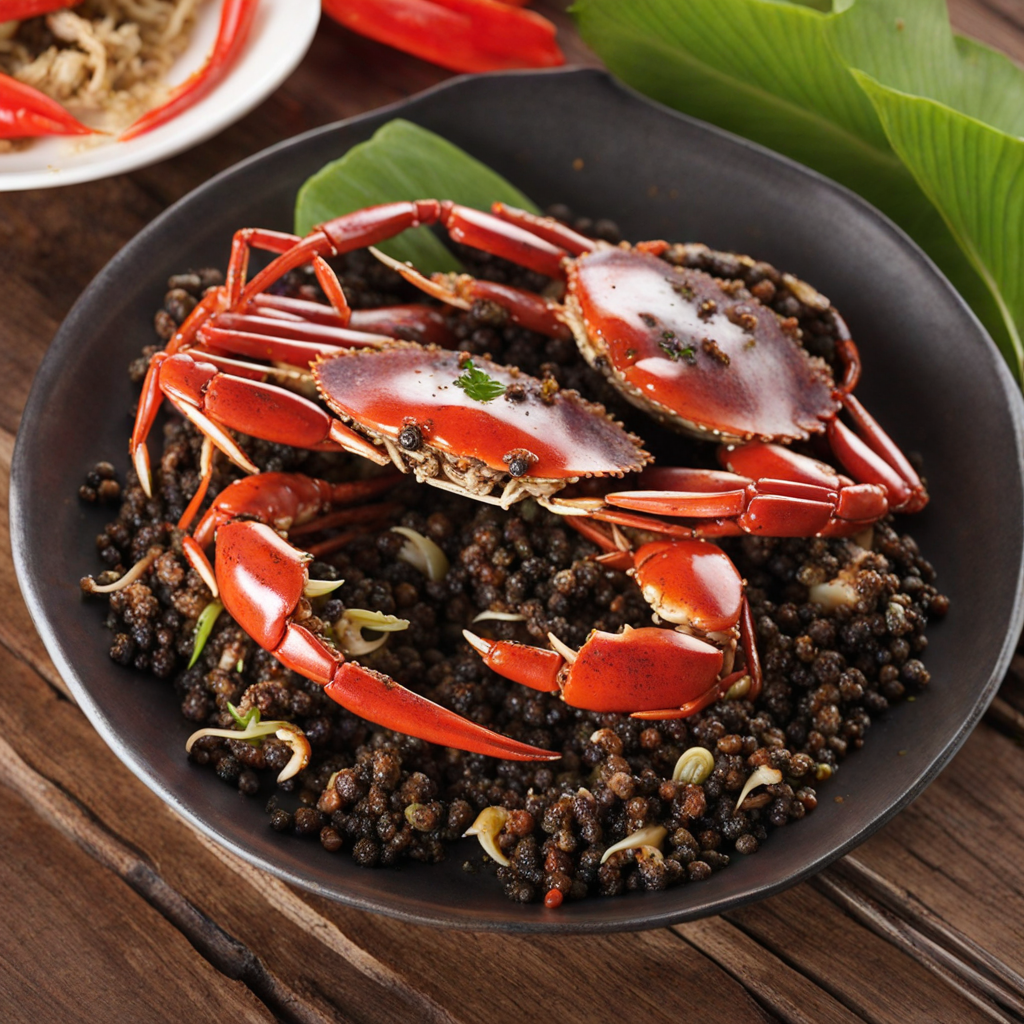Ang Dtray-Meuk
Ang Dtray-Meuk is a delightful Cambodian dish that features grilled squid, known for its tender texture and smoky flavor. The squid is marinated in a blend of traditional Khmer spices, including garlic, lemongrass, and lime juice, which infuse it with a refreshing zest. The grilling process enhances these flavors, creating a perfect balance between the charred exterior and the succulent, juicy interior. Served hot from the grill, Ang Dtray-Meuk is often accompanied by a tangy dipping sauce made from fish sauce, lime, and chili, providing a delightful kick that complements the dish beautifully. The presentation of Ang Dtray-Meuk is as enticing as its flavor. The grilled squid is typically arranged on a platter, garnished with fresh herbs like cilantro and mint, and sometimes served alongside a colorful array of vegetables. Each bite reveals the squid's natural sweetness, enhanced by the aromatic marinade, while the dipping sauce adds an extra layer of complexity with its salty and sour notes. It's a dish that not only pleases the palate but also excites the senses with its vibrant colors and aromatic scents. Ang Dtray-Meuk is often enjoyed as a street food delicacy, making it a popular choice among locals and tourists alike. The experience of savoring this dish while enjoying the bustling atmosphere of a Cambodian night market adds to its allure. Whether you are a seafood lover or simply looking to expand your culinary horizons, Ang Dtray-Meuk offers an unforgettable taste of Cambodian cuisine that is both satisfying and exhilarating.
How It Became This Dish
The Enigmatic History of អាំងទ្រីមឹក (Angtriemuk) in Cambodian Cuisine Introduction In the vibrant tapestry of Cambodian cuisine, one dish stands out not only for its unique flavor profile but also for its intrinsic connection to the land and culture of Cambodia: អាំងទ្រីមឹក, or Angtriemuk. This dish, which translates to "grilled fish with herbs," encapsulates the essence of Cambodian culinary traditions, weaving together the country's history, cultural significance, and evolving gastronomic practices. Origins of Angtriemuk Angtriemuk finds its roots in the rich agricultural and aquatic landscapes of Cambodia. Historically, the Khmer people have relied heavily on the Mekong River and its tributaries, which teem with diverse fish species. The availability of freshwater fish has significantly influenced Cambodian diets for centuries. Early records suggest that the Khmer Empire, flourishing from the 9th to the 15th centuries, utilized local fish in their diets, often preparing them with herbs and spices abundant in the region. The use of fish in cooking is not unique to Cambodia but holds a special place in Khmer culture, where it symbolizes life and sustenance. The tradition of grilling fish over an open flame, as seen in Angtriemuk, likely emerged as a practical cooking method suited to the rural lifestyle of many Cambodians. The simplicity of the technique, combined with the fresh ingredients, allowed families to enjoy nutritious meals while connecting to their local environments. Cultural Significance of Angtriemuk Angtriemuk is more than just a dish; it is a cultural artifact that reflects Cambodian values, traditions, and social practices. Food in Cambodia is deeply intertwined with communal life, and Angtriemuk is often served during family gatherings, celebrations, and festivals. The dish embodies the spirit of sharing, as families and friends come together to enjoy grilled fish, accompanied by fragrant herbs and vegetables. The preparation of Angtriemuk also highlights the importance of fresh ingredients in Cambodian cooking. In a country where the concept of "farm to table" resonates strongly, Angtriemuk emphasizes local sourcing and seasonal eating. It is common for families to catch fish from nearby rivers or markets, ensuring that the dish remains connected to the rhythms of nature. This practice fosters a sense of community and sustainability, reinforcing the bond between people and their environment. Moreover, Angtriemuk is often accompanied by a variety of dipping sauces, reflecting the diversity of flavors present in Cambodian cuisine. These sauces, typically made with ingredients like lime, chili, and fish sauce, enhance the dish's taste and illustrate the Khmer preference for balancing sweet, salty, sour, and spicy flavors. The act of dipping food is a social ritual that encourages interaction and connection, further highlighting the dish's cultural significance. Development Over Time As Cambodia has evolved through centuries of history, so too has Angtriemuk. The dish has experienced adaptations influenced by various historical events, including the rise and fall of empires, colonization, and globalization. The Khmer Rouge regime in the 1970s brought profound upheaval and disruption to Cambodian society, leading to significant changes in food availability and preparation methods. Many traditional recipes were lost or altered during this turbulent period. In the years following the fall of the Khmer Rouge, there has been a resurgence of interest in preserving and revitalizing traditional Cambodian cuisine, including Angtriemuk. Chefs and home cooks alike began to explore the rich culinary heritage of Cambodia, seeking to reclaim lost recipes and techniques. This revival movement has fostered a deeper appreciation for Angtriemuk, with many contemporary chefs experimenting with innovative presentations while honoring its traditional roots. Today, Angtriemuk can be found in various forms across Cambodia, from street food vendors to upscale restaurants. While the core elements of the dish—grilled fish, fresh herbs, and dipping sauces—remain intact, regional variations have emerged. Different types of fish, such as tilapia, snakehead, or catfish, may be used depending on local availability. Additionally, the choice of herbs and vegetables can vary, reflecting the diverse agricultural practices across the country. The globalization of cuisine has also played a role in the transformation of Angtriemuk. As Cambodian food gains international recognition, chefs are incorporating modern culinary techniques and presentation styles, appealing to a broader audience. This evolution has led to a fusion of flavors, where traditional Cambodian ingredients are combined with influences from other culinary traditions, resulting in exciting new interpretations of Angtriemuk. A Contemporary Revival In recent years, there has been a concerted effort to promote Cambodian cuisine on the global stage, and Angtriemuk has become a symbol of this culinary renaissance. Food festivals, cooking classes, and culinary tourism initiatives have highlighted the dish, introducing it to new audiences and fostering appreciation for its cultural significance. Moreover, the rise of social media has allowed food enthusiasts and chefs to showcase Angtriemuk, sharing recipes, cooking techniques, and personal stories associated with the dish. This digital platform has contributed to a sense of community among those passionate about Cambodian cuisine, encouraging the sharing of knowledge and experiences. Conclusion Angtriemuk stands as a testament to the resilience and adaptability of Cambodian cuisine. Its rich history, cultural significance, and evolving nature reflect the spirit of the Khmer people and their connection to the land and water. As Cambodia continues to navigate the complexities of the modern world, Angtriemuk serves as a reminder of the importance of preserving culinary traditions while embracing innovation. In a globalized culinary landscape, Angtriemuk remains a cherished dish that invites both locals and visitors to savor the flavors of Cambodia. As it continues to evolve, this grilled fish dish will undoubtedly retain its status as a beloved symbol of Cambodian culture and heritage, inviting future generations to explore and celebrate its rich history.
You may like
Discover local flavors from Cambodia


